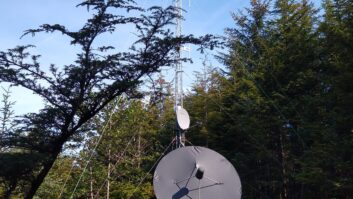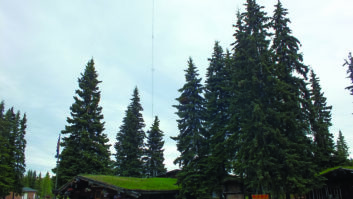The author and his wife live on a log cabin on the grounds of KJNP(AM) in North Pole, Alaska, near Fairbanks. This is the first in a series about the process of replacing the station’s tower.

KJNP Radio has just finished celebrating 50 years of broadcasting from the city of North Pole. Founded by Don and Gen Nelson to broadcast the Gospel to Alaska and the Arctic, it went on the air in October 1967. Don Nelson later wrote a book “Shadows on the Arctic Snow” that details the start of KJNP Radio; the station has even been recognized as a historic part of Alaska by the state Office of History and Archaeology. Today we also have two FM signals, a TV station and translators.
Over the years the operation has changed from having DJs to operating with an automation system É from getting programs in by 16-inch LP, to cassettes, then CDs and now the internet. But with all the technical and operation changes, there are a couple of people who have been there from its beginning; Dick Olson and Bonnie “Yvonne” Carriker are still involved on a daily basis. And the purpose of the station has not changed; it is still broadcasting the Gospel to Alaska and the Arctic. Having begun at 10,000 watts, the AM is now a 50,000 kW signal that gets listener reports from as far as Sweden, Finland, eastern Russia and New Zealand.
Recently, after some other towers in the area had problems and needed to be replaced, we decided to have ours inspected for structural integrity.
The Nolan Brothers tower crew from Soldotna did an inspection and found that the legs were no longer within the acceptable tolerance for wall thickness; they had corroded from the inside. The outer paint and guy wires were OK, but internally the metal had been oxidizing. They found the problem throughout, not in just one area.

The 425-foot hollow-leg tower has been in use for 50 years. This is a 5/8-wave tower, taller than a lot of AM structures because we make use of skywave to cover the Arctic.
We also have temperatures that range from above 80 degrees Fahrenheit in the summer to below minus-60 in the winter. This is a temperature change of over 140 degrees, which can cause stress on junctions and connections, especially when various metals are used. Copper and steel have different amounts of thermal expansion and contraction, which needs to be planned for in the construction. It can also affect the tuning of the tower and ATU at different seasons.
With this information in mind, we are going to be replacing the tower this summer. The tower will be in the same location, same height and face, same feed type. We want to reuse as many things as we can, like the ATU and coax. The replacement will be a solid-leg model from Magnum Towers.

GROUND WORK
When we started planning the replacement, we realized that we would also need to replace the ground system. It would be damaged during the tower work; and it had been in the ground for 50 years.
We started with the project last fall so that everything would be ready for tower work in the spring.
Part of the job was clearing the area of the tower field. Over time, the edges had grown in, even though the center was being mowed. We had a brush clearing company, TJ’s Landclearing, and a dirt work company, Alaska Groundworks, come do that.

After we picked up everything that had been stored on the edges of the tower field, they got things ready for the ground radials that will go in come summer. The tower field is now cleared and leveled to the original size; the guy anchor points are again in the field instead of among brush on the edges.
We are going to go with a pile foundation for the replacement tower. To plan for the foundation, we had soil samples taken down to 40 feet at two locations. Homestead Drilling did these in one day. They were analyzed by an engineering company that then designed the pile foundation. The piles were driven by Alaska Groundworks, two for the tower and one for each guy anchor. With those steps done last fall, we won’t need to wait for frost to be melted before starting things in the spring.

GEARING UP
We are in the process of getting everything ordered and purchased so that when we start the actual work, all is ready. Shipping to Alaska can take time and is expensive. Fairbanks and North Pole are more than 300 miles from any other large city, and going to town to get supplies usually is not an option.
Previously, for large items, instead of commercial shipping we have done the shipping ourselves, getting the tower loaded on a large trailer and driving it up. We are looking at doing this again for this project.
Reginald “Redgy” Swedberg is the engineer for KJNP. He has been with the station since 1991. Share your own project experiences. Write to [email protected].







